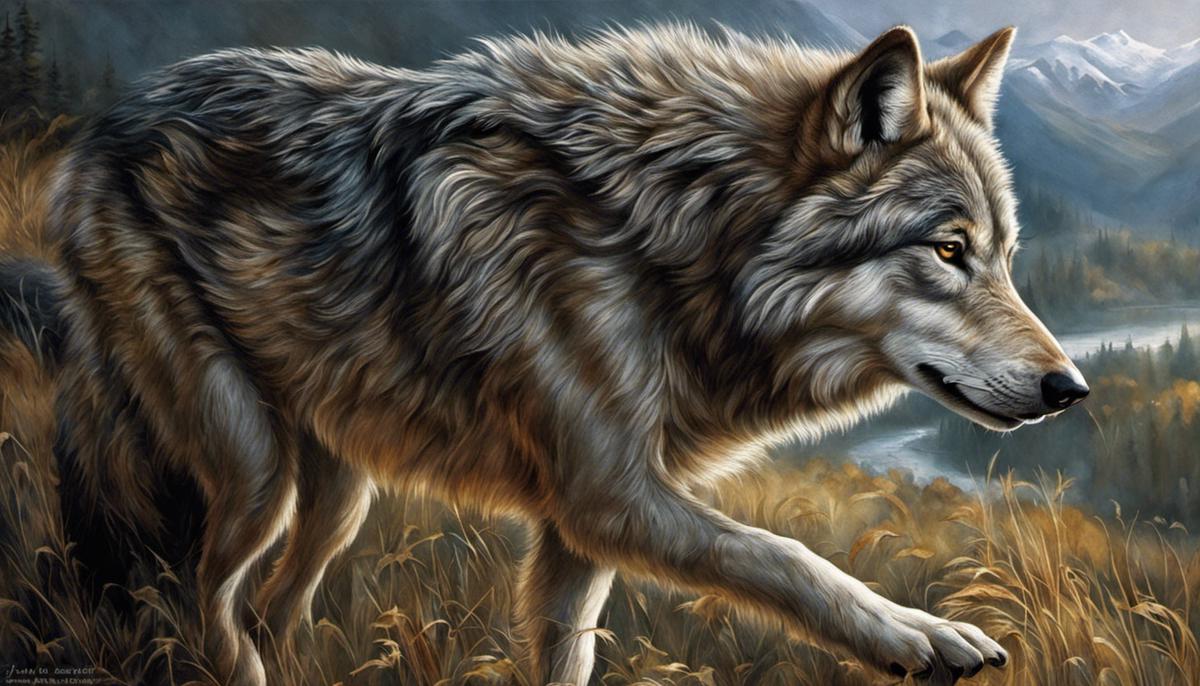In the realm of dreams and their interpretations, various symbols and figures hold significant meanings, their prominence shaped by religious, historical, and cultural contexts. Among these symbolic figures, wolves – especially black wolves – surface as a topic of immense interest due to their unique biblical connotations. This exploration seeks to unravel the biblical symbolism of wolves and the importance of color, particularly ‘black’, dedicating focus to their role and representation within the Christian doctrine. Moreover, it also extends the discussion to the methodology of dream interpretation through a biblical lens. Accentuating the overlap, the discourse provides a comprehensive understanding of intersections among the symbolism of wolves, the color black, and dream interpretation, thereby opening the door to decoding the hidden nuances behind dreams featuring black wolves.
Symbolism of Wolves in the Bible
A Scholarly Examination of the Wolf, as Symbolized within Biblical Texts
From Genesis to Revelation, the poetry and narratives of the Holy Bible are replete with animals symbolizing various facets of human nature, narrative plots, and divine interventions. One such distinguished creature is the wolf – a figure layered with profound symbolism that warrants a rigorous investigation.
To embark on this study, we first turn to the ubiquitous association of wolves with predation and destruction in biblical literature. One must understand this portrayal not as an indictment of the animal, but as a metaphoric representation to accentuate human attitudes and behaviors. Such an understanding is crucial when interpreting texts like Jeremiah 5:6, where the wolf is metaphoric of human adversaries, or Matthew 7:15-20, which issues a cautionary admonition towards deceptive individuals, termed ‘wolves in sheep’s clothing.’
Contrarily, the wolf’s representation also expands into the realms of transformation and redemption. The revered prophet, Isaiah, in his prophecics of peaceful utopia, portrays wolves lying with lambs (Isaiah 11:6). This noteworthy verse resonates with themes of radical change and reconciliation, instilling hope for altered circumstances and suggesting possibilities of harmony between erstwhile foes.
Another layer to the biblical representation of wolves lies in their correlation with leadership. This association draws from their complex social structures and astoundingly coordinated hunting strategies. Wolves are evident leaders, exhibiting a balance of assertiveness and group solidarity. This attribute finds parallel in texts like Acts 20:29-30, albeit imbued with a negative nuance to caution against exploitative and abusive leadership.
There’s a fascinating duality within the biblical representation of wolves. On one hand, they symbolize danger, deceiving prophets, and predatory behavior. On the other hand, they represent transformation, redemption, and leadership. Undeniably, wolves within biblical texts serve to enrich the narrative, providing interpretive depth and moral truth.
While delving into symbolic interpretations, it’s essential to remember that the Bible, as profoundly significant literature, carries varied interpretations contingent upon cultural, historical, and personal perspectives. A comprehensive understanding of the representation of wolves within Biblical texts calls for an engagement with these varying interpretations, fostering a mosaic of insight that eclipses any one-dimensional interpretation.
Throughout centuries, the wolf, within its biblical context, continues to intrigue and enlighten scholars, readers, and theologians alike. Its dual nature reflects the complexities of human behavior, prompting introspection and critical thinking. Indeed, like the resonant howl of a wolf, the biblical symbolism of this majestic creature reverberates through the annals of religious literature, serving as a testament to the intricate brilliance of metaphorical language.
Thus, the biblical representation of the wolf is a kaleidoscope of symbolism, unearthing layers of meaning that invigorate our understanding of this seminal text. It transcends a mere literary device, morphing into a beacon of moral wisdom and a mirror reflecting the multitudes of human nature.

The Significance of Color in Biblical Symbolism
The Power of Black: A Deeper Look at Biblical Symbolism
Diving deeper into the complexities of biblical symbolism, we journey into the realm of color, particularly black. As we navigate this engaging study, it is essential to note that the usage of colors, like other symbols in biblical texts, often carries deep cultural, psychological, and spiritual implications.
Black is a poignant hue in many biblical texts. Often, it imbues the text with solemnity, expressing themes of darkness, loss, or judgment. Its advent in the Bible invites us on a journey through shadowed valleys, through a sense of despair or doom, reinforcing the gravity and seriousness of the circumstances described.
Key texts such as Job 3:5, where “Let darkness and black gloom claim it,” and Jeremiah 4:28, “Because of this the earth shall mourn,” shed light on this symbolism. In both instances, black is used to convey powerful images of desolation and despondency. The choice of ‘black’ as the color to express these weighty themes is highly indicative of a broader, anthropologically shared, cultural understanding that associates black with hardship and sorrow.
Additionally, black serves as a color of warning or divine judgment in biblical texts. The prophetic passage Ezra 5:10 reads, “They said to me, ‘Things are not going well for those who returned to the province of Judah. They are in great trouble and disgrace. The wall of Jerusalem has been torn down, and its gates have been destroyed by fire.’ ” Here, the ‘blackness’ conveyed through the destruction and fire represents divine judgment upon the people, offering a stark visual aid to reinforce the severity and consequences of disobedience.
Yet, intriguingly, the evolution of color symbolism in religious iconography also denotes the association of black with humility and repentance. Monastic orders across the Orthodox, Catholic, and Protestant traditions have adopted black as the color of their vestments, signifying humility and a renouncement of worldly vanity, reflecting the transformative power of repentance. This simultaneous representation of transgression and redemption underscores the sophistication of biblical symbolism.
Furthermore, the Bible leverages the dichotomy of black and light to illustrate spiritual realities. Notably, the use of contrasts such as “Darkness vs. Light” in John 1:5, “The light shines in the darkness, and the darkness has not overcome it,” provides vivid metaphors for moral and spiritual struggles, highlighting the perpetual conflict between good and evil.
As we navigate these passages, it becomes increasingly clear that color, specifically black, plays a significant role in shaping the poetic, prophetic, and moral fabric of the Bible. The multiplicity of meanings associated with this color—encompassing judgment, doom, repentance, humility, and spiritual warfare—enhances the rich tapestry of pictorial language within biblical literature. This fascinating exploration underscores engaging intersections of culture, theology, and psychology in biblical symbolism.

Biblical Dream Interpretation
Pivoting now to the principles that guide biblical dream interpretation, it’s essential to note that interpretation requires an integration of contexts – both immediate and broader biblical context. The reason you can’t detach a symbol or concept from its immediate surrounding passage is because the writer’s intention plays a critical role in conveying meanings. In biblical times, dreams were seen as messages from the divine, treated with reverence, and held great influence over personal and national decisions.
The overall theme of a dream should be the first consideration. For instance, if a dream consists primarily of peaceful symbols, then that particular context should shape the interpretation of other symbols within that dream. Interpretation is not an isolated event but a continuous thematic analysis verifying the congruity of symbols within the perceived message.
Further, keep in mind that while historical interpretations offer valuable insights, they can occasionally embody cultural biases of their time, necessitating careful scrutiny, while balancing it with current understandings. Biblical hermeneutics, the science of interpreting texts, serves as a methodology in dream interpretation as well as parallel analysis of historical sources, cultural contexts, and theological doctrines.
Applying these principles to the interpretation of black wolves, it’s key to consider both the symbol of the wolf mentioned previously, highlighting its duality, and the implications of the color black within biblical contexts. As mentioned, black can symbolize themes of loss, judgment, desolation, but it can also signify humility and repentance. Providing an interpretation without considering the entirety of the dream would be a disservice to the manifold nuances of its symbols.
A singular standalone encounter with a black wolf within a dream might suggest an impending threat or a jeopardous entanglement, symbolizing the wolf’s predatory nature coupled with black’s association with divine judgment. However, if this encounter transpires in a peaceful utopia-like setting, as a part of a larger narrative in the dream, it could represent transformation through humility and repentance, incorporating the wolf’s theme of redemption with black’s connotation of humility and repentance.
In essence, biblical dream interpretation is a dynamic process. It demands engagement with the dream’s symbols, drawing together insights from biblical texts, cultural references, theological doctrines, as well as psychoanalytical perspectives into an interpretation that faithfully communicates the dream‘s message.
This fascinating intersection of theology, textual analysis, and psychology in biblical dream interpretation continues to captivate scholars’ attention, asserting the indomitable relevance of biblical symbols, such as black wolves, in modern discourse. The beauty lies in navigation through the layers of such symbols, transcending any monolithic interpretation and embracing extensive frameworks that intertwine historical, cultural, and psychological dimensions of this captivating academic pursuit.

Intersect of wolf symbolism, color symbolism and dream interpretation
In extending the exploration of our predefined themes into the interpretation of black wolves in dreams, it is essential to consider the combination of wolf imagery and color symbolism.
The integration of these symbolisms – wolves, often associated with predatory behavior, transformation, and leadership, and black, associated with darkness, loss, judgment – bears heavily on the interpretation of black wolves in dreams.
The sheer complexity of biblical symbolism alludes to the necessity of intricate interpretations, where symbols are not confined to a single meaning but are multifaceted. As such, the symbol of a black wolf does not solely denote a solitary meaning but a composite depiction that arises from the integration of color symbolism and wolf imagery.
When the wolf symbolism intersects with the color black, it amplifies certain characteristics attributed to the wolf. The black wolf morphs into an embodiment of spiritual discernment, symbolizing a form of judgment, darkness, or indication of loss. At the same time, the black wolf can represent an amalgamation of mystery, death, or transformation, given the wolf’s association with change and existential crises.
The dream in which the black wolf appears plays a vital role in interpreting the imagery. If the wolf appears threatening or ominous, it might echo biblical themes of enemies, perils, or fear. Alternatively, if the wolf appears peaceful or benevolent, it could evoke considerations of transformation and redemption, echoing biblical references to the wolf lying down with the lamb in a peaceful utopia.
When conducting a biblical dream interpretation, the principles of biblical hermeneutics come into play. Considering the wider biblical context, matters of the culture in which the dream occurs, and the possible personal significance of the symbol to the dreamer are all parts of this contextual thinking.
Dream interpretation is not a black and white process where symbols carry fixed meanings. It is a dynamic procedure that invites the exploration of possible connotations based on the dreamer’s personal associations and experiences, combined with broader cultural or theological contexts.
Interpretation of black wolves in dreams is influenced by the dream’s entirety and the narrative it builds, upon which the dream’s symbols derive their meaning. The dream’s context, coupled with the enormous symbolism of the wolf and the color black, can lead to a ranged interpretation – from signals of impending danger to heralds of profound transformation.
In essence, when pondering black wolf dreams, the intersectionality of wolf and color symbolism converts the interpretive work into a richly nuanced practice. This practice steps beyond the parameters of conventional interpretation by establishing that biblical dream interpretation is a dynamic process inviting introspection into the spaces of theology, textual analysis, and psychology.
Unveiling the symbolism of black wolves in dreams reinforces the relevance and captivation of exploring biblical symbols in contemporary conversations. It is yet another demonstration of the timeless appeal of biblical symbolism, extending continuously to inspire discourse and introspection in the world of dream interpretation.

Ultimately, the journey through biblical symbolism of wolves, the significance of color, notably ‘black’, and dream interpretation from a biblical standpoint, weaves a comprehensive tapestry that helps decode the esoteric messages in dreams with black wolves. Each element breathes life into various layers of interpretation, compiled meticulously after extensive exploration of religious scriptures and scholarly interpretations. The shared themes and patterns unearthed from this examination erect an insightful foundation for a deeper understanding of dreams, emphasizing how the symbol of a black wolf could hold poignant meanings. This discourse intends to illuminate the path towards a more thorough and profound grasp of biblical dream interpretation, significantly enriching one’s spiritual journey.







